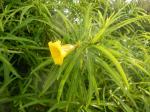Thevetia peruviana - Yellow oleander - Laurier jaune
Scoperto in Sardegna , ero rimasta abbastanza sorpresa del colore giallo intenso dei fiori di questo arbusto.
Guardandolo meglio, le foglie erano molto simili a quelle del "comune" oleandro ma, voi sapete bene che in Botanica
molte piante sono simili in certe loreo parti ma totalmente diverse!
Finchè quest'anno ho trovato il nume dell'arbusto: l'OLEANDRO GIALLO DEL PERU' .
Appartiene alla Famiglia delle APOCINACEE ed è roiginaria come tutti gli oleandri dell'America centro-meridionale. Ovviamente come tutti gli oleandri è VELENOSA in ogni sua parte e bisogna fare attenzione anche nel toccare foglie e fiori .
Si sviluppa pienamente nelle zone con clima mite e caldo o con temperature non sotto i 10°C dove va regolarmente annaffiata . Anche in zone temperate e non certo più calde può crescere bene se posta in luogo soleggiato ed al riparo dei venti. In inverno , inzone non calde, andrebbe riparata. Prefersice terreni normali ma non calcarei.
Le foglie sono lunghe e lanceolate , di colore verde brillante e lucido mentre i fiori dono a calice di color giallo intenso.
E' un vero spettacolo la fioritura che si allunga da marzo a fin quasi la fine dell'anno!
Much to my suprise I discovered that the huge shrub I saw a couple of years ago , which I also took a picture, it is the PERUVIAN YELLOW OLEANDER !
It is just gorgeous with its bright yellow funnel-shaped flowers make this small tree a real beauty to watch . This oleander belongs to the Family of APOCINACEE as all other oleanders and is native of central southern America . As all Oleanders, its leaves and flowers are poisonous .
The leaves are long and lanceolate of a bright glossy green and waxy coated to reduce water loss . The flowers are funnel-shaped and collected in few-flowered clusters.The shrub blooms from March to December but obiously it depends in which place it is located: in mild and hot regions , it just need to be watered regularly , while in a temperate or colder area , it must be protected during the cool season . It makes also some fruits in deep red-black colour , each containing a large seed that looks very close to the "Chinese lucky nut". It's great to see this shrub in blooming!

J'ai la belle surprise de decouvrir après 2 ans(!) que cet arbuste /petit arbre n'est que le LAURIER PERUVIEN JAUNE , de la Famille des APOCINACEE et une version extraordinaire des lauriers "normaux" qui dècorent nos villes . Originaire des régions du centre et du sud de l'Amerique , l'arbuste peut vivre dans nos règions chaudes mais aussi dans les pays un peu plus froids mais en s'assurent que pendant la season froide , on protège le laurier . Dans le régions chaudes , il faut l'aroser regulièrement .
Les feuills sont longues et étroites d'un vert très brillant . Les fleurs d'un jaune très fort . Il faut aussi faire toujours attention pusique le Laurier comme tpur les oleandres est fortement toxique soit dans les feuilles soit dans ses fleurs.
Très beau à voir !!





/http%3A%2F%2Fstorage.canalblog.com%2F92%2F85%2F1328290%2F103909513_o.jpg)
/http%3A%2F%2Fstorage.canalblog.com%2F57%2F20%2F1328290%2F105413404_o.jpg)
/http%3A%2F%2Fstorage.canalblog.com%2F24%2F67%2F1328290%2F105413325_o.jpg)
/https%3A%2F%2Fstorage.canalblog.com%2F30%2F21%2F1328290%2F133892611_o.jpg)
/https%3A%2F%2Fassets.over-blog.com%2Ft%2Fcedistic%2Fcamera.png)
/https%3A%2F%2Fstorage.canalblog.com%2F36%2F28%2F1328290%2F118806684_o.jpg)
/https%3A%2F%2Fstorage.canalblog.com%2F22%2F06%2F1328290%2F104946200_o.jpg)
/https%3A%2F%2Fstorage.canalblog.com%2F63%2F57%2F1328290%2F107485231_o.jpg)